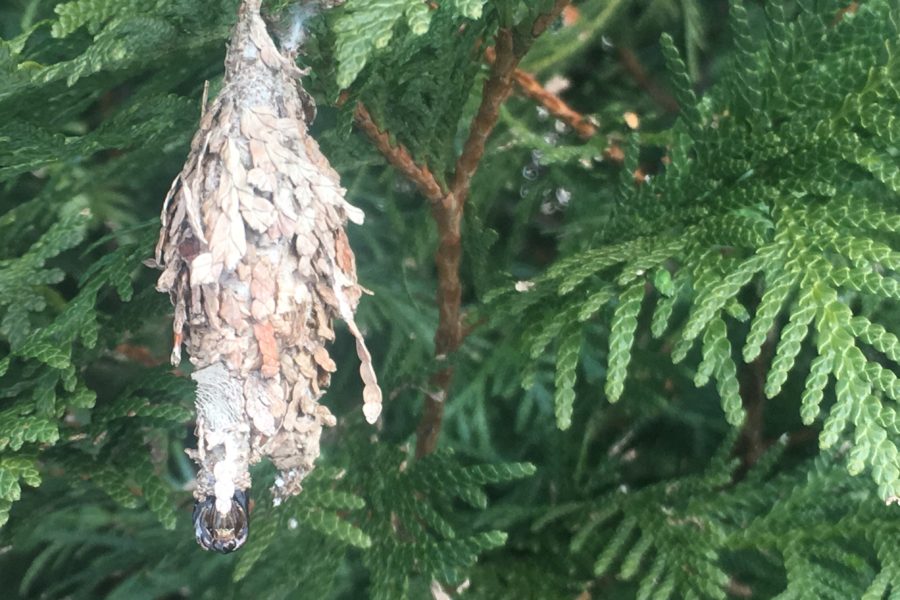I think Arborvitae (white cedar) is one of the most popular green fences in our climate zone (5-6). It is planted, without haste, along countless property lines and fence rows, either to hide old rusty chain link or cheap weathered panels of vinyl or wood, or out of spite, but in accordance with the zoning restrictions of suburbia. The arborvitae isn’t extravagant, it is economical. There are several varieties. Nursery stock is cheap, widely available and madly successful. It begs to be planted in a nice row somewhere. Or perhaps as a randomly unkept individual, circled by the lawnmower ten million times, or paired with another, or maybe three others, to hide the unnatural metallic hum of the air conditioner unit. True, as a monoculture it does have it’s problems (deer, bagworms), as all plants do, but it is a wonderful green boarder for privacy, acoustic and aesthetic buffering, and habitat.
Nests are always abundant, but recently I found one in particular made from old organic litter, and pruning scraps from formal hearings of this exact row in seasons gone by, plastic bags and fuzz from a mattress or a discarded pillow or a stuffed animal. A large, insulated clumpy mosaic of biotic and abiotic garbage. This must be the work of the malicious gray squirrel, a neighborhood staple, and like the arborist themselves, the carouser of many-a back yard. You will also, unfortunately, find hornets and wasps and yellow jackets hiding in the camouflaged wall of greenery, and with a puffy lip or cheek and a burning sweat in your eye, you will know the sting that comes with working the arborvitae hedge in June or July or August, in the tense, throbbing grasp of an unforgiving temperate summer.
In winter, with a fresh snow fall circling the chilly feet of the hedge, that bright royal green wall will surely be perched on by the wise little chickadee, or nibbled at under the stainless winter moon by the white-tailed deer, for what the animals loose in winter day length and sunlight, they get from the arborvitae in vitamin C by formally shearing it’s tender young growth. In the long, cold throws of winter, for the deer, it is a life saver. In the January gales there may be exposure to winter burn on the poorly placed specimens. The heavy snows of late February are sure to bend and break the long, whippy stocks of the arb, which is a good maintenance key that many times is a goal of pruning or supplemental support. Cultural care is easily justified on the arborvitae. It is the gift that keeps on giving.
If you have worked many-a mature arborvitae hedge for days on end along this yard or that, then you know well that this sea of green is not so much an emerald isle, but rather like trying to swim through the icy cold currents of the San Francisco Bay surrounding that infamous, inescapable prison. Arbatraz. When the arborvitae job calls, you bid it, do your time and just try to make it out alive.
Recently, I had done the dance. My orchard ladder set in place, I noticed there were a few cuts deeper inside of the hedge, yet out of range of my ladder position. So as the music cued, I put my right foot in and I shook it all about. Finding a scaffold just large enough that I thought would hold (because these small scaffolds do break easily), I tweaked my foot into place and brought my free hand around the back of the leader I was stepping onto. As the wind blowed we danced and swayed, but my ladder shifted ever so slightly, I got nervous and jolted, breaking my foothold. Small stubs of deadwood dragged against my forearm. I’ll have to think of another way. I’ll come up from below. I slink down the ladder and slide in between where two plants touch: the seam. A twig tangles in one of my ear muffs. I bob. I weave. I get poked in between the should blades by another stub. I am dancing in a dark alley of stems now, swinging my hand saw around to fend off the snarly tangle of dead branches. Although there is sunlight shining down through the top, I feel as though I am dancing in the dark.
I do the hokey pokey and I turn myself around. And that’s what the arb life is about.





Leave a Reply
Your email is safe with us.